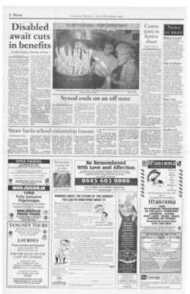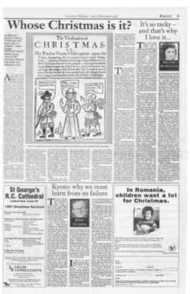Page 8, 19th December 1997
Page 8

Report an error
Noticed an error on this page?If you've noticed an error in this article please click here to report it.
Tags
Share
Related articles
Midnight In Th Heart Of
Countryside Memories Of The Season Of Goodwill To All
How Still We See Thee Lie...
The True Holy Of Holies
The Family Festival
Where shepherds watched?
In recognition of this special season of Christmas the Catholic Herald decided to make a parish in Bethlehem, the birthplace of Christ, the subject of this weekis Parish in Focus. With the assistance of the administrator of the Latin Patriarchate , Rev Ramzi Nimeh , Fr Majdi Al Siryani and Dr Costa Shomali have kindly prepared the following article : AmT THE SOUTHERN outskirts of Bethlehem and less than one kiloetre from the Nativity Basilica is the town of Beit Sahour which lies in close proximity to the desert of Judah. The 14,000 inhabitants of the city trace their roots back to the Bronze Age (circa. 3000 Etc). The name Beit Sahour actually stems from the Canaanite words "beet" meaning place, and "sahour" meaning night watch.
The Canaanites inhabited the numerous caves surrounding the city and traces of these inhabitants have been found in many of these caves which can be dated to Roman times. Indeed the remnants of oil presses and other findings demonstrate beyond any doubt that the city was inhabited at the time when Jesus was born in Bethlehem. It was only in the 16th century that houses rose up the mountain slope and spread to the present site of the town.
According to an ancient tradition, the shepherds who received the first tidings of the Nativity from the Angels received them on the slopes of the broad valleys of Beit Sahour (Luke 2:8-15). The precise location of the appearance is unknown but several sites have been venerated by Christians at different times. St Jerome (AD347-420) believed the field in which they appeared to be identical with that on which Jacob, long before, had spread his tent beyond the tower of Eder (Genesis 25,31). A church was erected at this site not long after St Jerome's time and there is mention of this church going back to the seventh century. For many centuries a monastery stood there and with the coming of the Crusaders there is mention of a cave which marks the site of the actual appearance.
As reflected by its name the town has a pastoral setting and would traditionally have had great significance for the shepherds who used it as a grazing site during daytime and as a place of safety for the flocks among the caves at night.
In addition to the Shepherds' field there is the field of Ruth where Boaz and Ruth met according to the Book of Ruth. It is somewhere in this area that the lyrical tale of Naomi and Ruth gleaning in the barley from the fields of Bethlehem took place and this has left an indelible mark on the minds of countless generations.
The town is also famous for its grottoes. The deepest one is known as Bir as-Sydah which, according to ancient traditions, was dug by Jacob the son of Isaac. The Virgin Mary, while on her way to Egypt, passed by it, and being thirsty and as the well was deep, she asked to be given a drink from a pail of water. The inhabitants refused to draw water for the Virgin but nevertheless the water rose in the well of its own accord. Not only Christians but also Muslims venerate this site as the scene of traditional miracles.
Today Beit Sahour is a Christian town with a Muslim minority. It is fairly prosperous and the home to many industries such as plastics, olive wood and clothing. However the events that befell the town after the civil disobedience which began in 1987, reflecting the residents refusal of and resistance to Israeli occupation, many businesses and small factories were confiscated.
The Latin parish of Our Lady of Fatima & St Theresa of Lisieux is under the jurisdiction of the Latin Patriarchate and counts just over one thousand parishioners. The church was built in 1859 and was re-ordered and transformed by Archbishop A Barluzzi in 1951 when it was dedicated to Our Lady and St Theresa. The parish team consists of one priest and three Rosary sisters. In close proximity is the Latin Patriarchate seminary and the relationship with the parish has been beneficial to both in the training of deacons, the maintenance of youth groups, the choir and liturgy.
The parish also has a school which is its right hand teaching catechetics and instructing children in their faith. Of even greater importance is the role of the school in nurturing peaceful coexistence between students of differing traditions including Christians of all denominations and Muslims. Christian schools have always been pioneers in this field offering their skills indiscriminately to all. In fact, these schools are the only place where Christians co-exist with Muslims since, even if they deal with each other on a daily basis, they remain closed to each other, having a different way of life. It is thanks to these schools spread all over the country (almost 300) that the two communities come to discover each other and know each other closely. The main problem with the schools is their running costs and it is in this area that we depend heavily on the financial assistance of the Vatican and the Knights of the Holy Sepulchre but it is an uphill struggle.
As Christmas arrives we can feel the joyous atmosphere rising. No matter how harsh the circumstances may be around us Christmas always means joy and happiness. The echo of the Angels tidings ring around "Glory to God in heaven and peace on earth" and grow louder and louder. We believe God's promises are true. We believe there will be peace in our region, but the question is 'When?". We, the people of Beit Sahour, were the first to believe in this message and to welcome the Prince of Peace but when is the hour of the victory of our Prince of Peace? This is the question we ask every Christmas.
Fr Majdi al Siryani & Dr Costa Shomali
blog comments powered by Disqus











